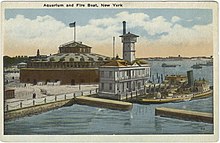Battery Park
From Wikipedia, the free encyclopedia
Battery Park is a 25-acre (10 hectare) public park located at the Battery, the southern tip of Manhattan Island in New York City, facing New York Harbor. The Battery is named for artillery batteries that were positioned there in the city's early years in order to protect the settlement behind them. At the north end of the park is Castle Clinton, the often re-purposed last remnant of the defensive works that inspried the name of the park; Pier A, formerly a fireboat station; and Hope Garden, a memorial to AIDS victims. At the other end is Battery Gardens restaurant, next to the United States Coast Guard Battery Building. Along the waterfront, ferries depart for the Statue of Liberty and Ellis Island, and there is also a New York Water Taxi stop. The park is also the site of the East Coast Memorial which commemorates U.S. servicemen who died in coastal waters of the western Atlantic Ocean during World War II, and several other memorials.
To the northwest of the park lies Battery Park City, a planned community built on landfill in the 1970s and 80s, which includes Robert F. Wagner Park and the Battery Park City Promenade. Together with Hudson River Park, a system of greenspaces, bikeways and promenades now extend up the Hudson shoreline. A bikeway might be built through the park that will connect the Hudson River and East River parts of the Manhattan Waterfront Greenway. Across State Street to the northeast stands the old U.S. Customs House, now used as a branch of the National Museum of the American Indian and the district U.S. Bankruptcy Court. Peter Minuit Plaza abuts the southeast end of the park, directly in front of the Terminal of the Staten Island Ferry.

The James Watson House, 1793–1806, attributed to John McComb Jr. and adjoining shrine to St. Elizabeth Ann Seton face Battery Park.
The southern shoreline of Manhattan Island had long been known as the Battery, and was a popular promenade since at least the 17th century. At the time, it served as protection to the town.[1] The Battery was the center of Evacuation Day celebrations commemorating the departure of the last British troops in the United States after the American Revolutionary War. The relatively modern park was created by landfill during the 19th century, resulting in a landscaped open space at the foot of the heavily developed mainland of downtown. Skyscrapers now occupy most of the original land, stopping abruptly where the park begins. On State Street, the former harbor front and the northern boundary of the park, a single Federal mansion survives (photo, right) as the Shrine of Saint Elizabeth Ann Seton. Until the 1820s, the city's stylish residential district lay north of this house, between Broadway and the "North River" (now known as the Hudson River).
Castle Garden
Within the park lies Castle Clinton, an American fort built on a small artificial off-shore island immediately prior to the War of 1812 and named for mayor DeWitt Clinton. When the land of Battery Park was created, it encircled and incorporated the island.According to data from the National Park Service, Castle Clinton was named the most popular National Park. Castle Clinton, site of the ticket office for ferries to the Statue of Liberty and Ellis Island, recorded nearly 4.08 Million visitors in 2009.[2]
The fort became property of the city after the war and was renamed Castle Garden. Leased by the city, it became a popular promenade and beer garden. Later roofed-over, it became one of the premier theatrical venues in the United States and contributed greatly to the development of New York City as the theater capital of the nation.
"After a New York clipper had finished loading, it was the custom for her to drop down the East River and anchor off Battery Park, then a fashionable resort, where she would remain for a few hours to take her crew on board and usually to ship between five and ten tons of gunpowder ... The people who gathered at Battery Park to see a clipper ship get underway came partly to hear the sailors sing their sea songs, or chanties ... which originated early in the nineteenth century, with the Negro stevedores at Mobile and New Orleans ... As the ship pays off, and gathers way in the slack water, the longshoremen and runners tumble over the side into the Whitehall boats, the crowd at Battery Park gives three parting cheers, the ensign is dipped, and the clipper is on her way to Cape Horn."[3]
The migration of the city's elite uptown increased concurrently with the mass European emigration of the middle 19th century. As immigrants settled the Battery area, the location was less favorable to theater patrons and Castle Garden was closed. The structure was then made into the world's first immigration depot, processing millions of immigrants beginning in 1855 - almost 40 years before its successor, Ellis Island, opened its doors. This period coincided with immigration waves resulting from the Great Hunger in Ireland (a.k.a., "The Irish Famine") and other pivotal European events. The structure then housed the New York Aquarium until the 1940s, when it was threatened with destruction. It is currently a National Monument known again by its original name, and managed by the National Park Service. In addition to a small history exhibit and occasional concerts, the fort is the site where ferry tickets are sold to visit Liberty and Ellis islands.
The Sphere
Five months after being damaged but not destroyed in the September 11, 2001 terrorist attacks, Fritz Koenig's The Sphere, which once stood at the center of the plaza of the World Trade Center a few blocks away, was reinstalled in a temporary location along Eisenhower Mall in the northern section of the park. There, along with an eternal flame, it serves to memorialize the victims of 9/11. Following the completion of the National September 11 Memorial, The Sphere will be returned to its original location. Underneath the park
Battery Park, due to its key location, has played an important role in the construction of transportation infrastructure. Under the park, there is the following active infrastructure:
- Brooklyn-Battery Tunnel, carrying vehicular traffic to Brooklyn
- Battery Park Underpass, carrying vehicular traffic from West Street to the FDR Drive
- IRT Broadway – Seventh Avenue Line and IRT Lexington Avenue Line with a balloon loop to enable trains to turn around and switch between the two IRT lines
- South Ferry subway complex.
Archaeological excavation
On December 8, 2005, New York City authorities announced that builders working on a new South Ferry Subway Station in Battery Park had found the remains of a 200-year-old stone wall.[4]"This wall most likely is a portion of the gun batteries that once protected the city in the late 17th and 18th centuries and gave rise to the modern park name," said Robert Tierney, chairman of the New York City Landmarks Preservation Commission. The city and the New York City Transit Authority plan to work together to preserve the remains, which were described as "an important remnant of the history of New York City."
A total of four distinct walls and over 250,000 individual artifacts were found in the excavation of the South Ferry Station and Tunnel. A portion of one wall was placed on temporary display inside Castle Clinton.






